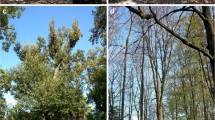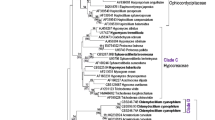Abstract
A smut fungus, Melanotaenium oxalidis, forming dark-coloured spores in the leaves of Oxalis oregana (Oxalidaceae) was collected a few times in the USA. A similar smut fungus on Oxalis acetosella was recently collected in Slovenia. Teliospores, hyphal septations, cellular interactions and ITS and LSU rDNA sequences of these two smuts on Oxalis were examined and the results obtained were compared with each other and with findings in other members of the Ustilaginomycotina. The data show that the specimen from Slovenia is very close to Melanotaenium oxalidis, but represents a new species, and that the two Melanotaenium species occurring on Oxalis are members of the Urocystidaceae. Among the Urocystidaceae, they are morphologically very similar to Flamingomyces, Melanustilospora and Vankya species, but differ from them, and from all other Urocystidaceae, by their multilamellate teliospore walls. In addition, molecular phylogenetic analyses indicated good separation of the Melanotaenium species from Flamingomyces, Melanustilospora and Vankya. Accordingly, a new genus, Melanoxa, and a new species, M. oxalidiellae, are described, and a new combination, Melanoxa oxalidis, is proposed for Melanotaenium oxalidis.






Similar content being viewed by others
References
Andrade O, Muñoz G, Galdames R, Durán P, Honorato R (2004) Characterization, in vitro culture, and molecular analysis of Thecaphora solani, the causal agent of potato smut. Phytopathology 94:875–882
Bauer R, Oberwinkler F, Vánky K (1997) Ultrastructural markers and systematics in smut fungi and allied taxa. Can J Bot 75:1273–1314
Bauer R, Vánky K, Begerow D, Oberwinkler F (1999) Ustilaginomycetes on Selaginella. Mycologia 91:475–484
Bauer R, Begerow D, Nagler A, Oberwinkler F (2001a) The Georgefischeriales: a phylogenetic hypothesis. Mycol Res 105:416–424
Bauer R, Begerow D, Oberwinkler F, Piepenbring M, Berbee, M (2001b) Ustilaginomycetes. In: McLaughlin DJ, McLaughlin EG, Lemke PA (eds) Mycota. VII, Part B: Systematics and evolution. Springer, Berlin, pp. 57–83
Bauer R, Lutz M, Oberwinkler F (2005) Gjaerumia, a new genus in the Georgefischeriales (Ustilaginomycetes). Mycol Res 109:1250–1258
Bauer R, Begerow D, Sampaio JP, Weiß M, Oberwinkler F (2006) The simple septate basidiomycetes: a synopsis. Mycol Prog 5:41–66
Bauer R, Lutz M, Piątek M, Vánky K, Oberwinkler F (2007) Flamingomyces and Parvulago, new genera of marine smut fungi (Ustilaginomycotina). Mycol Res 111:1199–1206
Bauer R, Lutz M, Begerow D, Piątek M, Vánky K, Bacigálová K, Oberwinkler F (2008) Anther smut fungi on monocots. Mycol Res 112:1297–1306
Begerow D, Bauer R (2000) Phylogenetic placements of ustilaginomycetous anamorphs as deducedfrom nuclear LSU rDNA sequences. Mycol Res 104:53–60
Begerow D, Bauer R, Oberwinkler F (1997) Phylogenetic studies on nuclear large subunit ribosomal DNA sequences of smut fungi and related taxa. Can J Bot 75:2045–2056
Begerow D, Stoll M, Bauer R (2006) A phylogenetic hypothesis of Ustilaginomycotina based on multiple gene analyses and morphological data. Mycologia 98:906–916
Boekhout T, Fell JW, O'Donnell K (1995) Molecular systematics of some yeast-like anamorphs belonging to the Ustilaginales and Tilletiales. Stud Mycol 38:175–183
Denchev CM (2003) Melanustilospora, a new genus in the Urocystales (smut fungi). Mycotaxon 87:475–477
Denchev CM, Giraud T, Hood ME (2009) Three new species of anthericolous smut fungi on Caryophyllaceae. Mycol Balcan 6:79–84
Dietz SM, Fischer GW (1970) Melanotaenium oxalidis sp. nov. on Oxalis oregana from Washington State. Mycologia 62:402–405
Gardes M, Bruns TD (1993) ITS primers with enhanced specificity for basidiomycetes - application to the identification of mycorrhizae and rusts. Mol Ecol 2:113–118
Gatesy J, DeSalle R, Wheeler W (1993) Alignment-ambiguous nucleotide sites and the exclusion of systematic data. Mol Phylogenet Evol 2:152–157
Giribet G, Wheeler WC (1999) On gaps. Mol Phylogenet Evol 13:132–143
Huelsenbeck JP, Rannala B (2004) Frequentist properties of Bayesian posterior probabilities of phylogenetic trees under simple and complex substitution models. Syst Biol 53:904–913
Huelsenbeck JP, Ronquist FR (2001) MRBAYES: Bayesian inference of phylogenetic trees. Bioinformatics 17:754–755
Huelsenbeck JP, Larget B, Miller RE, Ronquist F (2002) Potential applications and pitfalls of Bayesian inference of phylogeny. Syst Biol 51:673–688
Katoh K, Toh H (2008) Recent developments in the MAFFT multiple sequence alignment program (outlines version 6). Brief Bioinform 9:286–298
Katoh K, Misawa K, Kuma K, Miyata T (2002) MAFFT: a novel method for rapid multiple sequence alignment based on fast Fourier transform. Nucleic Acids Res 30:3059–3066
Katoh K, Kuma K, Toh H, Miyata T (2005) MAFFT version 5: improvement in accuracy of multiple sequence alignment. Nucleic Acids Res 33:511–518
Kemler M, Lutz M, Göker M, Oberwinkler F, Begerow D (2009) Hidden diversity in the non-caryophyllaceous plant-parasitic members of Microbotryum (Pucciniomycotina: Microbotryales). Syst Biodivers 7:297–306
Le Gac M, Hood ME, Fournier E, Giraud T (2007) Phylogenetic evidence of host-specific cryptic species in the anther smut fungus. Evolution 61:15–26
Lutz M, Bauer R, Begerow D, Oberwinkler F, Triebel D (2004) Tuberculina, rust relatives attack rusts. Mycologia 96:614–626
Lutz M, Göker M, Piatek M, Kemler M, Begerow D, Oberwinkler F (2005) Anther smuts of Caryophyllaceae: molecular characters indicate host-dependent species delimitation. Mycol Prog 4:225–238
Lutz M, Piatek M, Kemler M, Chlebicki A, Oberwinkler F (2008) Anther smuts of Caryophyllaceae: molecular analyses reveal further new species. Mycol Res 112:1280–1296
Matheny PB, Gossmann JA, Zalar P, Kumar TKA, Hibbett DS (2006) Resolving the phylogenetic position of the Wallemiomycetes: an enigmatic major lineage of Basidiomycota. Can J Bot 84:1794–1805
O’Donnell KL (1993) Fusarium and its near relatives. In: Reynolds DR, Taylor JW (eds) The fungal holomorph: mitotic, meiotic and pleomorphic speciation in fungal systematics. CAB International, Wallingford, pp 225–233
Piepenbring M, Bauer R, Oberwinkler F (1998a) Teliospores of smut fungi. General aspects of teliospore walls and sporogenesis. Protoplasma 204:155–169
Piepenbring M, Bauer R, Oberwinkler F (1998b) Teliospores of smut fungi. Teliospore walls and the development of ornamentation studied by electron microscopy. Protoplasma 204:170–201
Piepenbring M, Bauer R, Oberwinkler F (1998c) Teliospores of smut fungi. Teliospore connections, appendages, and germ pores studied by electron microscopy; phylogenetic discussion of characteristics of teliospores. Protoplasma 204:202–218
Piepenbring M, Begerow D, Oberwinkler F (1999) Molecular sequence data assess the value of morphological characteristics for a phylogenetic classification of the species of Cintractia. Mycologia 91:485–498
Piepenbring M, Stoll M, Oberwinkler F (2002) The generic position of Ustilago maydis, Ustilago scitaminea, and Ustilago esculenta (Ustilaginales). Mycol Prog 1:71–80
Posada D, Crandall KA (1998) MODELTEST: testing the model of DNA substitution. Bioinformatics 14:817–818
Prillinger H, Wuczkowski M, Lopandic K, Bauer R, Molnár O, Sterflinger K (2009) Schizonella caricis-atratae (Ustilaginomycetes): a new cryptic species on Carex atrata from Austria. Mycol Prog 8:157–164
Ronquist FR, Huelsenbeck JP (2003) MRBAYES 3: Bayesian phylogenetic inference under mixed models. Bioinformatics 19:1572–1574
Stoll M, Begerow D, Oberwinkler F (2005) Molecular phylogeny of Ustilago, Sporisorium, and related taxa based on combined analyses of rDNA sequences. Mycol Res 109:342–356
Vánky K (2002) Illustrated Genera of Smut Fungi, 2nd edn. APS, St. Paul, MN
Vánky K, Lutz M (2007) Revision of some Thecaphora species (Ustilaginomycotina) on Caryophyllaceae. Mycol Res 111:1207–1219
Vánky K, Lutz M (2010) Entyloma majewskii sp. nov. (Entylomataceae) on Ranunculus ficaria from Iran. Pol Bot J 55:271-279
Vánky K, Lutz M, Bauer R (2008) Floromyces, a new genus of Ustilaginomycetes. Mycotaxon 104:171–184
Acknowledgements
We thank S. Tóth for the Latin descriptions, C. Vánky and M. Weiß for critically reading the manuscript, M. Wagner-Eha and F. Albrecht for technical assistance, E. Bronner for preparing the line drawing, D. Begerow, U. Bloss and M. Kemler for their surpassing companionship on the field trips to Slovenia, and the anonymous reviewers for their helpful comments. The study was supported by the Deutsche Forschungsgemeinschaft.
Author information
Authors and Affiliations
Corresponding author
Rights and permissions
About this article
Cite this article
Lutz, M., Vánky, K. & Bauer, R. Melanoxa, a new genus in the Urocystidales (Ustilaginomycotina). Mycol Progress 11, 149–158 (2012). https://doi.org/10.1007/s11557-010-0737-7
Received:
Revised:
Accepted:
Published:
Issue Date:
DOI: https://doi.org/10.1007/s11557-010-0737-7




